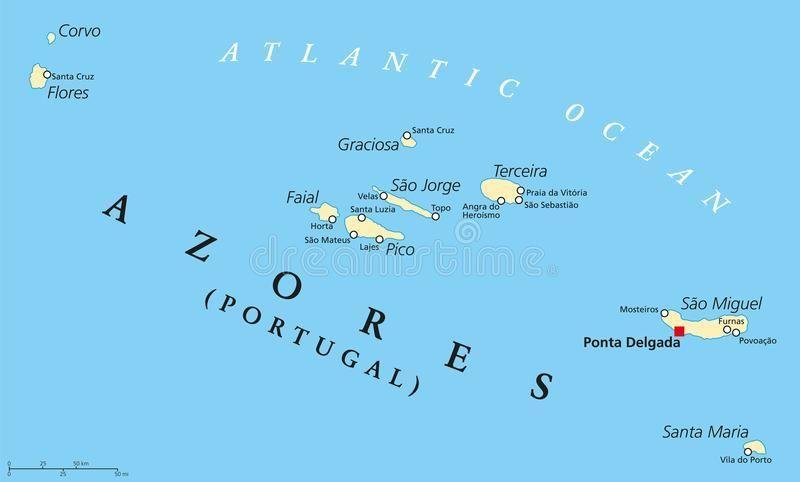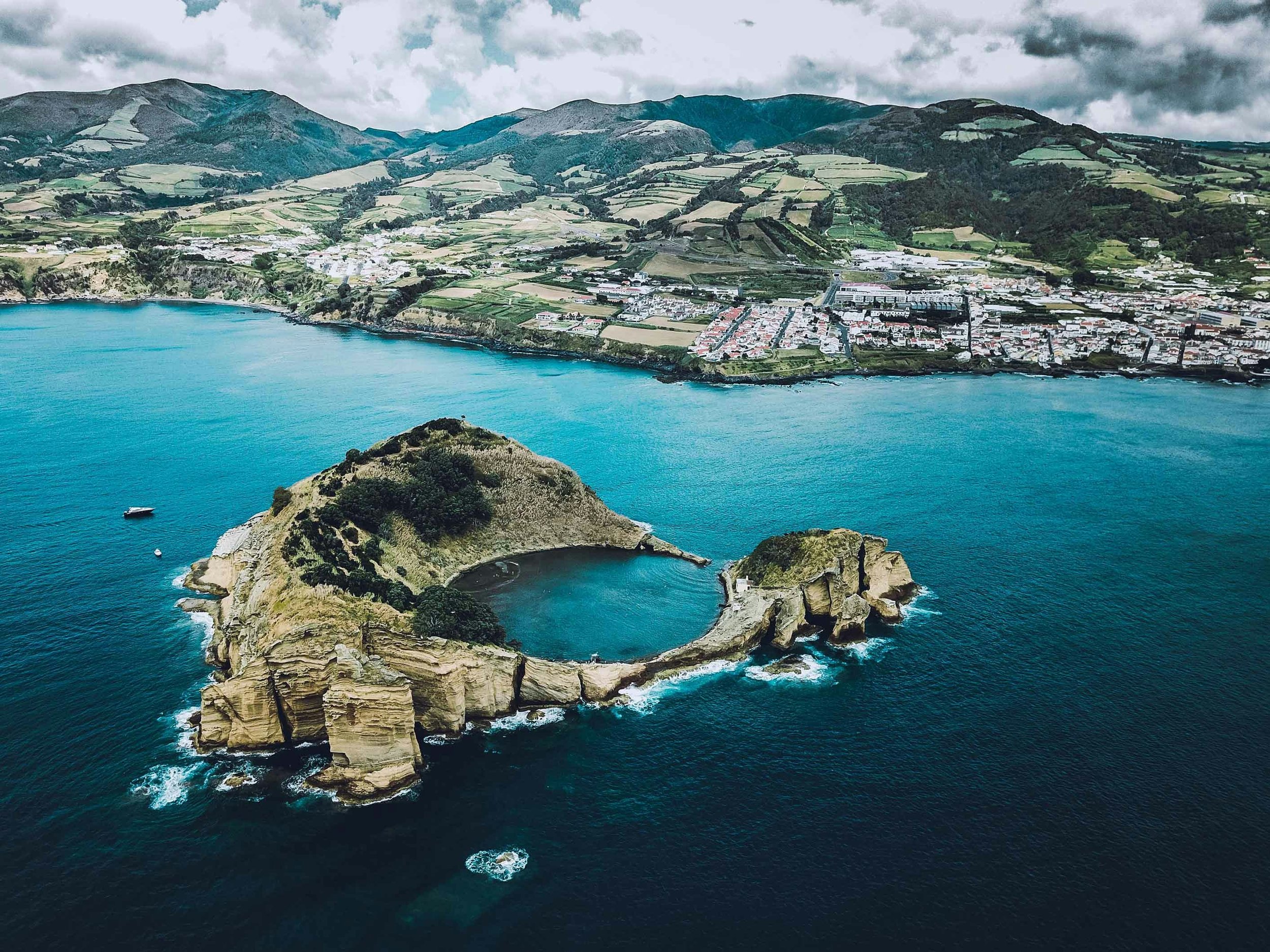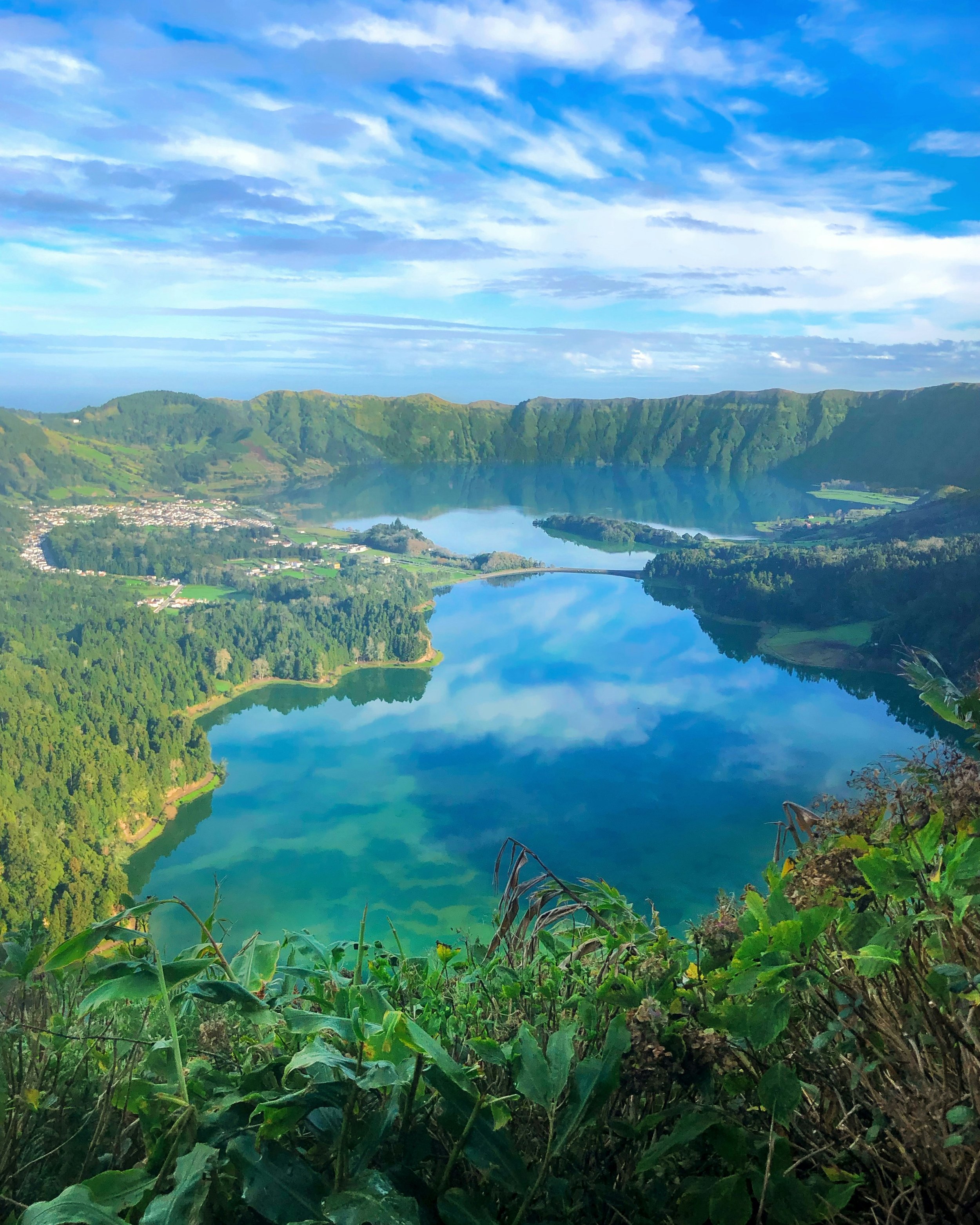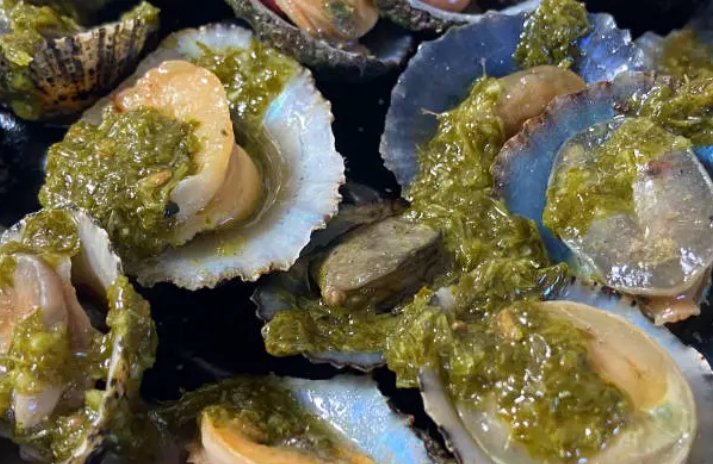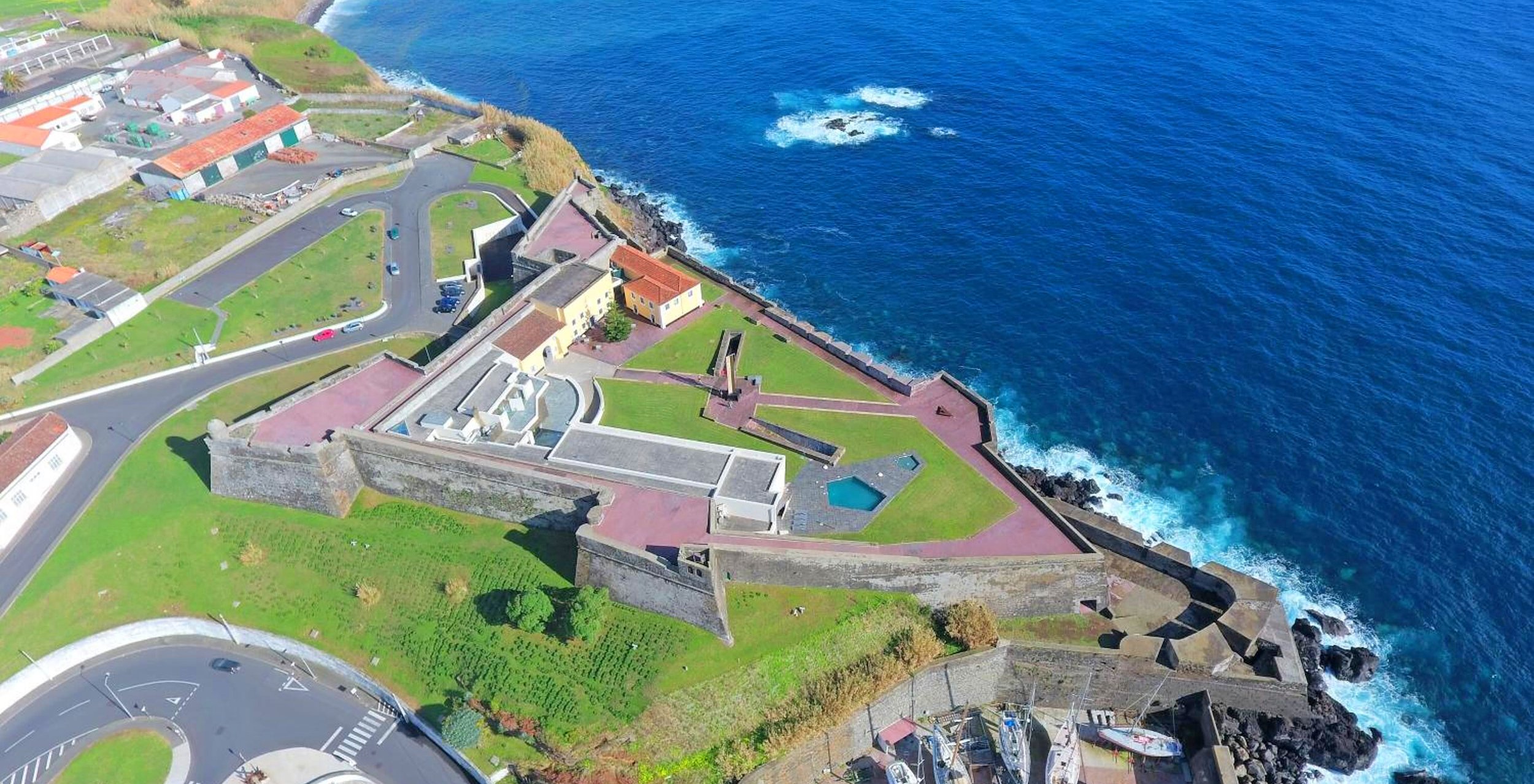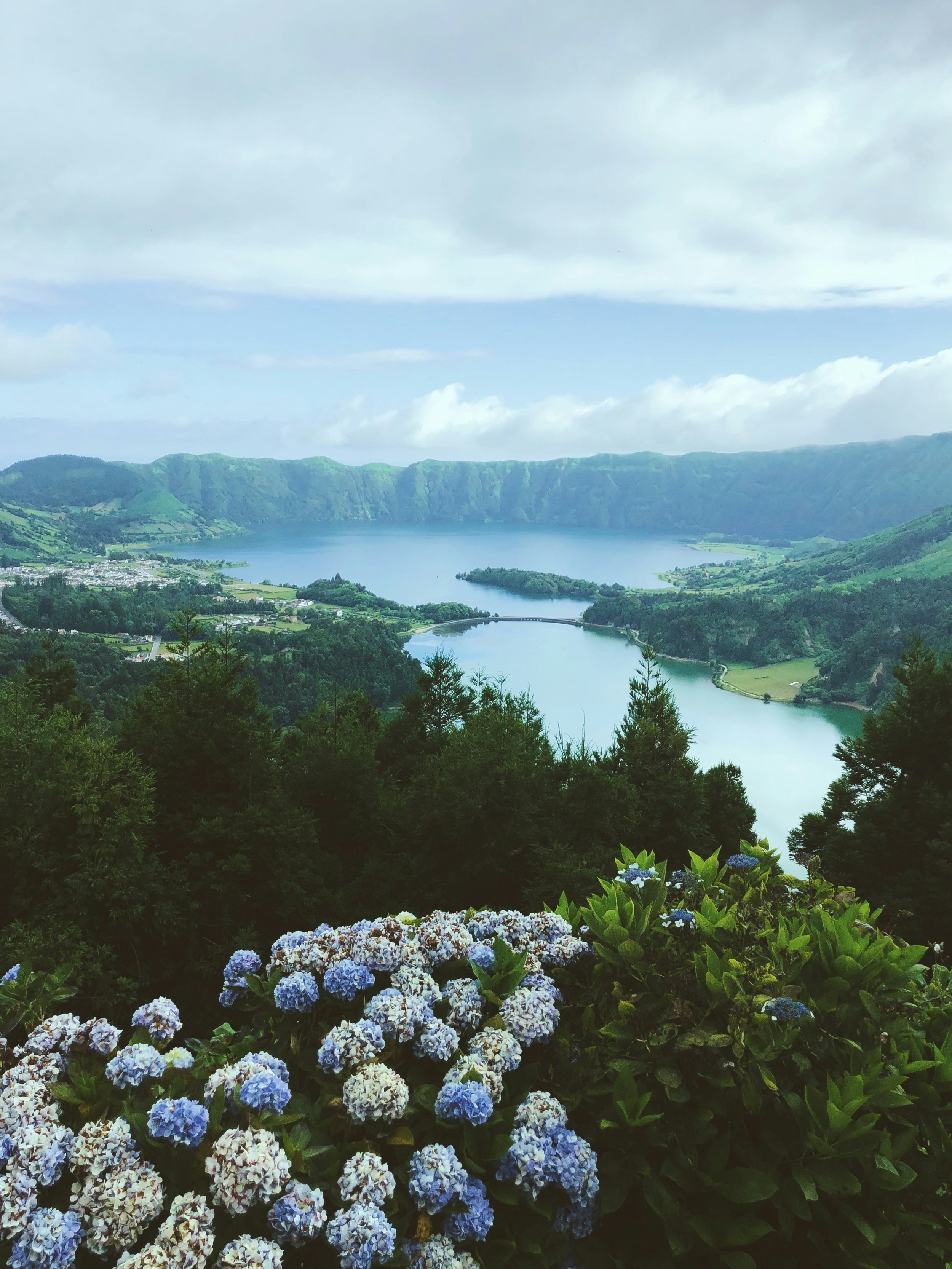Destination Guide to the Azores
Discovering the Azores - Your Guide to Portugal’s Best-Kept Secret
Map of Azores. Image: maps-portugal.com
Discover What Is So Special About The Azores
Floating in the middle of the Atlantic Ocean, roughly 1,500 kilometres west of Lisbon, the Azores are a stunning archipelago of nine volcanic islands that feel like a well-kept secret. Rugged cliffs, crater lakes, steaming hot springs and emerald-green pastures make this remote region of Portugal one of Europe’s most unique and jaw-droppingly beautiful destinations.
Whether you’re seeking adventure, relaxation, or just a breath of fresh air far from the crowds, here’s your ultimate guide to exploring the Azores as a holiday destination or on visit by a cruise ship.
Which Island Should You Visit?
One of the islands of the Azores. Photo by Ferdinand Stöhr on Unsplash
Each island in the Azores has its own character, so your choice depends on what you’re after:
São Miguel – The largest island and easiest to reach. Known as “The Green Island”, it’s famous for its dramatic landscapes, twin crater lakes at Sete Cidades, and geothermal wonders like the hot springs of Furnas.
Pico – Home to Portugal’s highest mountain (Mount Pico) and renowned for its striking volcanic terrain and UNESCO-listed vineyards.
Faial – A paradise for sailors and whale watchers. The town of Horta is a must-see for its marina filled with colourful sailor murals.
Terceira – Offers a mix of nature and history, with its UNESCO-listed capital, Angra do Heroísmo, and vibrant cultural scene.
Flores & Corvo – Remote and wild, perfect for serious nature lovers and hikers seeking solitude.
When is Best Time to Go to Azores?
The Azores enjoy a mild, maritime climate year-round. Summer (June to September) brings the warmest temperatures and best chance of sunshine, making it ideal for hiking, swimming and whale watching. But spring and autumn are quieter, cheaper, and equally scenic.
Spring (March–May)
Temperature: 14°C–20°C (57°F–68°F)
Weather: Mild with occasional rainfall, particularly in April. It’s a great time to visit for fewer tourists and lush green landscapes.
Summer (June–August)
Temperature: 20°C–26°C (68°F–79°F)
Weather: Warm and mostly sunny, although temperatures rarely exceed 30°C (86°F). Summer is the peak tourist season, with long, dry days and pleasant evenings.
Autumn (September–November)
Temperature: 18°C–24°C (64°F–75°F)
Weather: Still quite warm in September but cooling down by November. Rain increases, especially later in the season. This is a quieter time for tourists, with beautiful sunsets and fall colours.
Winter (December–February)
Temperature: 12°C–17°C (54°F–63°F)
Weather: Cool and rainy, but rarely freezing. Storms and wind can occur, especially in December and January. Winter is the least busy season, offering a more serene experience for those who don’t mind unpredictable weather.
Due to the islands’ location in the Atlantic, weather conditions can change quickly, so it’s always wise to pack layers and prepare for varying conditions, even in summer.
Top Things to Do in the Azores
Visit Sete Cidadea. Photo by Anna Jewels on Unsplash
1️⃣ Visit Sete Cidades (São Miguel)
A stunning volcanic crater with twin lakes – one blue, one green – surrounded by forested cliffs. Drive to the Vista do Rei viewpoint or rent a bike to cycle around the rim.
2️⃣ Soak in Hot Springs at Furnas (São Miguel)
Relax in the thermal pools at Terra Nostra Park or Poça da Dona Beija, and try a traditional cozido stew cooked underground by volcanic heat.
3️⃣ Climb Mount Pico (Pico)
For adventurous souls, a guided hike up Portugal’s highest peak (2,351m) offers epic views and bragging rights. It’s a tough but rewarding climb.
Dolphin Watching in the Azores Photo by Ty Tomlinson on Unsplash
4️⃣ Go Whale and Dolphin Watching
The Azores are one of the best spots in the world for marine life. Tours run year-round, with sperm whales, dolphins and even blue whales making appearances.
5️⃣ Explore Lava Tubes and Caves
Gruta das Torres on Pico is the longest lava tube in Portugal, while Algar do Carvão on Terceira takes you into an ancient volcanic chimney.
6️⃣ Swim in Natural Pools
From the lava pools of Biscoitos (Terceira) to Ferraria’s hot spring pools in the sea (São Miguel), the Azores are packed with stunning swim spots.
Getting Around
Flights and ferries connect the islands, with São Miguel and Terceira offering the most international flights. Once on an island, hiring a car is the best way to explore – public transport is limited and doesn’t reach remote spots.
Azores Beaches
One of the dramatic beaches in the Azores. Photo by sara nudaveritas on Unsplash
Whilst the Azores are known for their dramatic landscapes, lush greenery, and tranquil beauty, they also boast some of the most unique and serene beaches in Europe. Whether you’re looking for a peaceful retreat or an active day of water sports, the beaches of the Azores have something to offer every type of traveller.
Praia Formosa (São Miguel)
Located just a short drive from Ponta Delgada, Praia Formosa is the largest beach on São Miguel Island. This black sand beach is perfect for a day of sunbathing, swimming, or simply soaking in the stunning scenery. The surrounding cliffs and greenery create a picturesque backdrop, making it an ideal spot to relax and unwind.
Santa Bárbara Beach (São Miguel)
Famed for its surf-friendly waves, Santa Bárbara Beach on the north coast of São Miguel is a hotspot for surfing enthusiasts. The beach’s black sand and sweeping views make it a picturesque location to relax or take a walk. Whether you’re riding the waves or simply enjoying the scenery, it’s a must-visit spot for any traveller.
Praia de Água d’Alto (São Miguel)
This black sand beach, located near Ribeira Chã, offers a more peaceful atmosphere, with calm waters and a backdrop of volcanic hills. It’s perfect for a relaxing day out, whether you’re swimming, sunbathing, or just enjoying the serene surroundings.
Praia da Vitória (Terceira)
One of the most popular beaches in the Azores, Praia da Vitória on Terceira Island features golden sand and calm, clear waters. With plenty of nearby facilities and a relaxed atmosphere, it’s ideal for families or anyone looking to spend a day at the beach.
Prainha de São Lourenço (Graciosa)
For a more secluded beach experience, head to Prainha de São Lourenço on Graciosa Island. This small, golden-sand beach is surrounded by cliffs, offering a tranquil setting with excellent conditions for swimming and snorkeling.
The beaches of the Azores are not just for sunbathing – they’re perfect for water sports, relaxation, and exploring the stunning landscapes of this Atlantic paradise. Whether you’re visiting São Miguel, Terceira, or any of the other islands, you’re sure to find a beach that suits your style.
Food & Drink
Lapas grelhadas - an Azorean delicacy
Azorean cuisine is hearty and delicious, with fresh seafood, tender beef, and locally grown pineapples, tea and cheese. Don’t miss:
Lapas grelhadas – Grilled limpets with garlic and lemon.
Cozido das Furnas – Meat and veg stew cooked underground.
Queijo São Jorge – A tangy cheese from the island of São Jorge.
Azorean wine – Especially from Pico’s unique basalt vineyards.
Is It Expensive?
The Azores are generally affordable compared to mainland Portugal or other European islands. Entry to most attractions is either free or low cost, and you’ll find plenty of small, family-run guesthouses, especially outside peak season.
“If you truly love nature, you will find beauty everywhere.”
Where to Stay in the Azores
Accommodation in the Azores ranges from charming rural guesthouses to chic boutique hotels and modern apartments. Check listings on sites such as Booking.com or AirBnB, or book a package via a travel agent. Whether you’re looking to wake up in a cosy cottage overlooking a crater lake or a stylish suite in a seaside town, there’s something to suit every budget and travel style.
São Miguel
Best for first-time visitors and a wide choice of stays
Ponta Delgada – The capital city offers the most hotels, from historic city centre stays to modern waterfront resorts. Great base for exploring the island with plenty of restaurants, shops, and tour operators.
Try: Octant Ponta Delgada for upscale ocean views or Casa das Palmeiras for boutique charm in the heart of the city.
Furnas – Ideal if you want to stay near hot springs and nature. Think spa hotels and tranquil retreats.
Try: Terra Nostra Garden Hotel for luxury and access to its famous thermal pool.
Pico
Best for hikers, nature lovers and wine enthusiasts
Madalena – The island’s main town is perfect for easy access to ferries, local restaurants, and Pico’s iconic vineyards.
Try: PocinhoBay for design-led luxury by the sea or Vinhas do Calhau for modern self-catering suites with vineyard views.
Faial
Best for sailing vibes and island hopping.
Horta – A laid-back port town popular with yachties and backpackers alike. Stay close to the marina for sea views and sunset drinks.
Try: Azoris Faial Garden Hotel for resort-style comfort or Porto Pim Guest House for a budget-friendly, central stay.
Terceira
Aerial view of Pousada Forte Angra do Heroísmo
Best for culture, history and volcanic landscapes.
Angra do Heroísmo – A UNESCO-listed town with cobbled streets, colonial buildings, and sweeping bay views. Plenty of characterful B&Bs and guesthouses.
Try: Pousada de Angra do Heroísmo (set in a historic fortress) or Hotel Cruzeiro for a more modern option.
Flores & São Jorge
Best for escaping the crowds.
These more remote islands are ideal for travellers seeking peace and wild nature. You’ll find small, family-run guesthouses and eco-lodges rather than big resorts.
Try: Aldeia da Cuada on Flores for a unique stay in a restored village, or Intact Farm Resort on São Jorge for stunning views and a back-to-nature vibe.
Good to Know
Book early in peak season (June to September) – especially on smaller islands, where accommodation is limited.
Self-catering apartments are common and a great option for longer stays or travelling families.
Many places include breakfast and can help organise tours, car hire or local experiences.
Azores Sustainability & Nature
The Azores pride themselves on being a sustainable tourism destination. The Azores is the first island archipelago in the entire world to achieve international certification as a sustainable destination. Over 60% of the land is protected, and eco-conscious travellers will love the islands’ focus on clean energy, conservation, and preserving local culture. It is a great location for whale and dolphin watching.
How to Get to the Azores from the UK
Portuguese Airline Tap Air flies to the Azores Photo by Isaac Struna on Unsplash
While the Azores may feel like a world away, getting there from the UK is easier than you might think. Direct flights and growing interest from tour operators mean you can escape to this lush Atlantic paradise with minimal hassle – and no long-haul jet lag.
Flights from the UK
Direct flights to the Azores operate seasonally from the UK, mainly to Ponta Delgada (São Miguel).
Azores Airlines (SATA) typically offers a direct weekly flight from London Gatwick to Ponta Delgada between spring and autumn (flight time: approx. 4 hours).
Alternatively, fly via Lisbon or Porto with TAP Air Portugal or Ryanair, then take a short onward flight to any of the nine islands. Connections to São Miguel, Terceira, Faial, and Pico are the most frequent.
Tip: If you’re visiting mainland Portugal as part of a wider trip, adding on the Azores is easy and often surprisingly affordable.
Tour Operators Offering Azores Holidays
Several UK-based travel companies now offer Azores packages, which can include flights, hotels, transfers, car hire and guided tours. Amongst these are:
Archipelago Choice - A specialist tour operator offering specialised travel to inspiring destinations.
Azores Holidays - a small tour operator which has been arranging bespoke holidays since 1992.
Sunvil – One of the UK’s most established tour operators for the Azores, offering flexible tailor-made holidays, island-hopping itineraries and self-drive packages.
Explore – Offers small group adventure tours that combine hiking, culture and wildlife across multiple islands.
Inntravel – Specialises in slow travel, with walking holidays on São Miguel and Pico featuring boutique stays and mapped routes.
Ramblers Walking Holidays – Offers guided walking tours, often with expert local leaders and a focus on geology, flora and birdlife.
TUI – Occasionally offers package holidays to São Miguel, including flight and hotel bundles with optional excursions.
Jet2 Holidays – Has previously included the Azores in its range from regional UK airports – worth checking for updates as the destination gains popularity.
Azores in Spring time. Photo by Isa Jokela-Gomes on Unsplash
Cruise Stopovers
Don’t forget, the Azores are also featured on a number of cruise itineraries – a relaxed way to sample one or more of the islands without the need to plan flights or accommodation. Great for transatlantic crossings or island-hopping itineraries with cruise lines such as Marella, P&O Cruises, Cunard, and Azamara.
Read my related article: Cruise Destination Focus: The Azores
Final Thoughts
Unspoilt, uncrowded and unforgettable – the Azores are like stepping into another world. Whether you’re hiking across ancient calderas, swimming in volcanic pools, or sipping wine by the sea, this Portuguese paradise is perfect for those looking to unplug and reconnect with nature.

